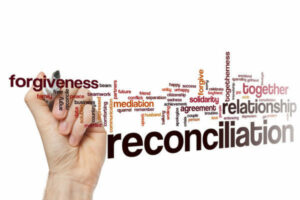
Conflict is inevitable. No surprise. The question is how we resolve conflict. The most emotionally intelligent people in any field or walk of life understand conflict management. They don’t deal with conflict management by retreating or sweeping it under the rug, nor by coming off as aggressive and imposing their will on others. They learn to draw others into give-and-take conversations in which they share their own point of view while making it safe for others to do the same. As they do so, they create a shared understanding of a situation from which to find solutions and move forward.
Become a master at resolving conflict by clicking here.
My Learnings on Conflict Management
My purpose is to make it easier for you to resolve conflict by teaching you a structure and process for initiating and navigating sensitive conversations successfully. I’m going to teach you a four-phase process to resolve conflict, which I’ve gleaned from my years of professional experience. I hope they are helpful as you step up to the relationship challenges in your life.
By the way, I’ve written a case study so you can see the actual application of these steps. Access this now or later as you continue reading this article.
Phase I of Conflict Management: Preparation

The preparation phase of conflict management is about stepping back, if only briefly, and putting yourself in the right frame of mind. Of course, some conflicts are unanticipated so you don’t have time to prepare. However, just understanding the steps of this phase will empower you to deal with them more effectively.
Sometimes we’re tempted to just “wing it” but then find ourselves in a heated conversation in which we lose our bearings, overreact, and are not sure how to move forward productively. It becomes easy to slip into harmful patterns of communicating. So, preparation is key. The more you prepare the more confident and successful you’ll become in dealing with all kinds of conflict.
Three Conflict Resolution Steps in Preparation
First, understand a few key principles about the nature of the conflict to resolve conflict.
- Conflict management is not about “winning” or getting your way, which quickly leads to defensiveness and polarization. It is about building a shared understanding and finding common ground so you can find solutions that work for all parties. This requires that we care about what is important to each of the people involved.
- There is not a “right” and “wrong” way to view a situation. There are many points of view, all of which have some truth and validity. It does not help to approach conflict by believing that your point of view is the truth, whole truth, and nothing but the truth, which only alienates others. Better to be open and willing to understand how others see things.
- Conflict management requires that we make it safe for people to talk. We make it safe as we communicate respect and a sincere desire to understand their point of view. Once they know that you will listen and really hear them, they will be open to your point of view.
- Recognize that conflicts are not the result of bad intent (on anyone’s part) but rather poorly chosen strategies for dealing with unmet needs and/or negative feelings. It is, therefore, more helpful to become curious about the feelings that are driving another’s behavior rather than assume that they are acting from negative, malicious motives.
Understanding these core principles prepares us to enter into conflict-solving conversations in a way that makes it much more likely we’ll achieve good outcomes.
The second step in preparation to resolve conflict is to work through your own thoughts and feelings.
Conflict is not just about what is happening “out there” but what is happening “in here” or inside of you. Therefore, effective conflict management requires you to grow in emotional intelligence and acquire the ability to manage your thoughts and feelings in tough situations to resolve conflict. You grow in this ability as you learn to process your inner experience by working through questions like the following:
- What am I feeling? What are my unmet needs beneath my feelings?
- How can I calm myself and put myself in a good place mentally and emotionally?
- What’s the story (thoughts) I’m telling myself that’s causing my feelings and driving my behavior? Are my thoughts fear or trust-based?
- Am I willing to tell myself a different or more helpful story?
- What story is the other person telling him/herself? How is it different from my story? Can I see some truth in their story? How can I interpret their behavior in a more charitable light?
Asking such questions interrupts your tendency to simply react and act out your feelings. It allows you to gain deeper insight into yourself and, more importantly, make new choices about how to handle a sensitive conversation. Doing this kind of self-assessment is essential in learning to resolve conflict.
Step three is to strengthen your commitment to collaboration and seeking win/win outcomes by thinking through such questions as the following.
- What is my intent going into this conversation? (Punish? Win? Vent? Learn? Build trust?)
- Can I show respect?
- Am I concerned for us and not just me?
- Will I take responsibility for my feelings rather than blame?
- Can I seek shared understanding rather than building my own case?
- Am I willing to be curious to understand the point of view of the other party? Can I listen and draw them out?
- Am I committed to being authentic as opposed to being political or playing games?
- Will I take the time necessary to arrive at a good outcome?
Answering these questions affirmatively doesn’t mean you won’t feel some anxiety and apprehension about your ability to manage the process or get to a good outcome. But answering them affirmatively does help you deepen your commitment to play a positive role.
Become a master at resolving conflict by clicking here.
Phase II of Conflict Management: Invitation

The second phase of conflict management is about opening up a conversation in a way that helps the parties feel safe enough to talk openly about their differences to resolve conflict. We’re trying to create a context of safety, respect, and openness so that we experience one another as allies rather than adversaries, so people will want to cooperate.
Research tells us that a conversation that starts poorly will end poorly 96% of the time. If it feels harsh in the beginning it will almost always feel harsh at the end. It is very hard to recover from a poor start which is why this phase is so important.
The most important skill in the initiation phase is leveling. A leveling message has three parts.
- First, you get an issue out on the table without communicating blame or hostility.
- Second, you express your desire to understand the other person’s point of view (which makes it safe for them to talk).
- And third, you let them know you want to work things out together.
These statements are usually fairly short and to the point. You’re not jumping into a discussion of the facts of a situation. You’re neutralizing a situation and extending an invitation to talk. Here are a couple of examples:
“I was surprised by what you said this morning during our coffee break. It seems you have some strong feelings about this matter which I’d like to understand. I wonder if we could talk about it either now or later today when it’s more convenient for you.”
“I’d like to talk about Dad’s will. I think we have a different understanding of what he intended and what is fair to each of us. I’d like to understand your point of view and share mine as well and see if we can work this out without getting into an ugly family battle.”
You can not only use a leveling statement at the start of a conversation but also when you’re in the middle of a heated discussion and realize it’s not going well. For example:
“Hey, Rajiv, I’m not feeling good about how this is escalating and you’re probably not either. I want to understand how you’re feeling and what we can do to calm our discussion and get it back on track.”
Become a master at resolving conflict by clicking here.
Other Invitation Skills
There are a few other skills you may use during the invitation, or throughout the dialogue, to make sure you stay on track. One skill is clarifying your intent. This is making contrasting statements that make your motives for talking more apparent and take some of the apprehension out of talking.
For example, “I don’t intend to say you’re at fault here. I do intend to say that I think it’s something we both have some responsibility for.” Or, “I don’t mean to say we have a poor relationship. I do mean to say that there are a few issues I need to discuss so we can work even better together.” Or, “I don’t want to throw cold water on your plans. However, I do want to share a few thoughts and give you some input.”
You make such statements when it would be easy for someone to misunderstand why you want to talk or when they don’t trust your motives or your desire to understand and support them.
Clarifying Concerns
Related to clarifying your intent is clarifying concerns. The idea is to get any concerns about entering into dialogue out into the open at the beginning. Being open about concerns deals directly with the reasons people may be hesitant to talk openly and thereby diffuses these issues and makes it safer to enter into a conversation. It makes the conversation more real, helps establish your credibility and authenticity, and builds greater trust in both the communication process and the relationship. Others know that you’re sensitive to their deeper reservations.
Here’s an example. “A concern I have in talking is that our relationship will be harmed. Please know that I only bring this up so we can better understand each other and resolve whatever is keeping us from working well together.”
Or, “I’m concerned that by bringing this up you’ll misunderstand my loyalty and support of you in your role as my boss.” You can then go on and say, “I am supportive and don’t want you to doubt that because I bring this issue to your attention.”
So, you think about any hesitancy or resistance that you or the other person may feel about entering into a conversation. If natural, early in the conversation, you share this and then give the person a chance to comment. It is important, after they do so, that you reassure them of your positive intent and commitment to their interest as well as your own.
Stating Your Commitment to Collaboration
Another skill, during the invitation, is stating your commitment to collaboration. This is making statements that sound like, “My intent is to be helpful and not divisive.” “My motive is that each of us come away feeling heard and able to come up with solutions that we can agree upon.” “I want this to be a win for you as well as for me.” “It’s important to me that we talk about this in a way that feels respectful and collaborative.” “I want to own my part in what is happening in our relationship. I don’t want you to get the idea that I blame you.” And so on.
These statements diffuse apprehension on the part of the other party and make it more likely that they’ll engage with you in a constructive conversation to resolve conflict.
You will most always start the conversation with a leveling statement and then use the other skills if it seems like things could go off-track. They help create an atmosphere of trust and safety and let the other person know that your intent is to be constructive.
Become a master at resolving conflict by clicking here.
Phase III of Conflict Management: Exploration

https://traineracademy.org/
Exploration is the heart of conflict management. It is exploring the viewpoint of each (or all) parties, not to solve the problem, which comes in the next phase, but to create a “pool of shared understanding.” This shared understanding is not agreement. It is getting all points of view on the table before you move to find solutions.
The reason for creating a pool of shared understanding is so important is that no one point of view represents the whole truth. All people bring diverse perspectives, biases, roles, needs, values, and backgrounds to the table, which set you up to arrive at different conclusions about the meaning of events. It’s through communication that you bridge these differences and develop a more complete understanding of what’s going on.
In fact, there is a good body of research that proves that our understanding and solutions are better the more points of view we take into account as we solve our problems. After all, two heads are better than one. Nobody is smarter than everybody. (See James Surowiecki’s best-selling book The Wisdom of Crowds as evidence of this point.)
The Skills of Inquiry and Advocacy
The exploration phase includes two major skills—inquiry and advocacy. The inquiry is encouraging others to disclose their point of view or inner experience and then listening with empathy. You inquire, by asking questions like: “How do you see things?” “What are your thoughts and/or feelings about what is going on?” Or even, “Help me understand how you arrived at your perceptions and assumptions?”
Advocacy is disclosing your point of view or inner experience. “This is the situation as I see it.” “These are my thoughts and/or feelings about what is going on.” “This is how I arrived at my perceptions and assumptions.” Then you end advocacy with an inquiry, “How do you see it differently?”
You go back and forth and back and forth, balancing inquiry with advocacy and advocacy with inquiry until you come to a shared understanding of all points of view. This process is not linear. It’s not like you go around the room taking turns stating your point of view. You allow the conversation to evolve naturally, one person speaking at a time with others listening to understand his or her point of view, no one person dominating airtime.
This may go on for some time until it seems like all viewpoints have been stated or have been added to the pool. If someone is leading the conversation he or she may ask, “Is there more anyone has to say? Are we missing anything? Is there anything that has been shared that anyone does not understand?”
The process looks like this:

When people learn this process, they sometimes object because they think it takes too much time. It is true that the process takes more time in the short run but also results in much-improved relationships, a better understanding of complex situations, and better solutions to resolving conflict. It actually saves time in the long run by avoiding longstanding misunderstandings, unproductive conflict management, and ongoing infighting.
Mistakes During Exploration
You can make two mistakes during the exploration phase. First is trying to persuade, convince, or coerce others into accepting your point of view. This sets them up to do the same and pretty soon you’re polarized around who’s right and who’s wrong which only creates resistance and power struggles. (“Tastes great!” “Less filling!”)
This also causes you to dichotomize, oversimplify, and distort the truth. You want to win and so only pay attention to the data that supports your point of view and fail to pay attention to the complexities of a situation and valid points that others have to make.
The second mistake you can make is moving too quickly into problem-solving, the next phase of the process. It’s tempting to rush into looking for solutions to the problem before you have a really good understanding of the problem and everyone’s point of view. Not only does this result in people arguing for their own solutions but prevents you from getting enough information into the shared pool to come up with the best solutions.
Become a master at resolving conflict by clicking here.
Phase IV of Conflict Management: Collaboration
We’re now in the final phase of conflict management—collaboration. This is like coming full circle since collaboration is the name of one of the styles of communication. The entire dialogue process ends in the phase of collaboration.
As this word implies, we’re now working together to come up with and implement solutions and actions that all parties can agree upon. Hopefully, at this point, we aren’t pitted against each other or competing to have our way but feel like we’re members of the same team working together to find the best solution. We’ve gotten here by establishing trust and goodwill and by creating a pool of shared understanding. During the collaboration, we translate our goodwill and shared understanding into tangible solutions and actions.
Three Steps of Collaboration
There are three steps in achieving solutions during collaboration. Step one is to identify the needs of what is important to each party in order to come up with a good solution to resolve conflict. Unmet needs are often at the heart of conflict management. And rather than being aware and expressing our needs directly, we’ve learned to send blaming and judgmental messages. For example, a husband says, “You spend so much time at work. I’m beginning to think you love your work more than you love me.” His hurt and blaming message is really expressing an unmet need for intimacy or connection.
important to each party in order to come up with a good solution to resolve conflict. Unmet needs are often at the heart of conflict management. And rather than being aware and expressing our needs directly, we’ve learned to send blaming and judgmental messages. For example, a husband says, “You spend so much time at work. I’m beginning to think you love your work more than you love me.” His hurt and blaming message is really expressing an unmet need for intimacy or connection.
Or an employee of one department says, “Those people in sales are bozos. They make promises to customers without having a clue about what it takes to build a good product.” Again, this judgmental message covers up a deeper need someone has to feel respected and/or engage in more open sharing of information. Understanding the needs behind such statements helps us avoid overreacting and so we can search for solutions that meet the needs of all parties.
So, this step is not yet looking for a solution, but finding out what is really important to people. By identifying what is important, you give yourself the flexibility to explore various solutions that can meet all needs and avoid getting locked into power struggles. Your needs and deeper concerns, therefore, become the criteria against which to compare possible solutions.
Now let me say that needs may have already been expressed during the exploration phase of dialogue. They may have been stated as part of building a pool of shared understanding. However, you still raise the question and make what is important explicit during collaboration by asking questions that invite people to share their needs. You do this by asking such questions as, “What is most important to you as we search for a solution?” Or, “What needs do you have that need to be met for you to know that we’ve solved this problem?” You then get these needs out in the open.
Here’s a simple example. It’s Friday evening and a couple is facing a problem to resolve conflict about what to do this evening. She wants to go to dinner and a movie and he wants to watch a program on tv. As long as they argue about solutions, they’re likely to remain stuck or eventually set up a win/lose situation. However, if they can identify their deeper needs, they can choose from a wider selection of options and have a better chance of finding a solution that meets both their needs.
So, she may ask, “What is most important to you tonight?” He may say, “It has been a hectic week for me and I want to relax and not have to interact with other people.” She may then share, “What is important to me is time together and to be away from responsibility for kids.” These needs are deeper than going to a movie or watching tv. By understanding one another’s needs, this couple can be more flexible as they brainstorm various solutions that may work for both of them.
If we’re talking about two departments, engineering and sales, pitted against each other and invite each to share what is most important to them, we might hear sales say, “It is important that we give our customers answers right away about when they can expect the product.” Or, “It’s important to us that we consistently meet production deadlines.” Perhaps engineering would say, “It is important to us to have a process that captures all customer requirements upfront.” Or, “It is important that all departments involved agree on the process and steps required to produce a deliverable.”
Of course, this example is hypothetical and the list of what is important may be longer than these few items. But I hope you’re getting an understanding of the kinds of ideas people will come up with as they identify their needs or what is important to them. The take-away is that you want to be sure that you’ve given each party the opportunity to make their needs, or what is important to them, explicit as you move into searching for solutions.
Become a master at resolving conflict by clicking here.
Brainstorming
The second step is brainstorming alternatives. You’re not yet at the solution or action stage. You’re looking at options, as many as possible, before you settle on a solution. The idea here is to be flexible, think outside the box, and get as many possibilities out in the open as possible before settling on solutions. You do this by brainstorming.
Here are some rules for brainstorming:
- Make sure that everyone understands your objective in generating options.
- Each person shares ideas, round-robin, or spontaneously.
- One thought is expressed at a time.
- No criticism of any ideas.
- Outrageous ideas are encouraged.
- No discussion of ideas except to clarify their meaning.
- Build on other’s ideas.
In my example about a husband and wife trying to decide what to do on a Friday night, they want to be creative in coming up with options: Hire a babysitter. Take some alone time before doing something together. Go for a walk. Spend time in a park. Go to a quiet restaurant for dinner or dessert. Go to a movie if we don’t have to drive far. Watch a movie we both love on tv. And so on. They aren’t trying to push one idea on the other, just coming up with various options.
Not all of these options are going to be equally appealing to both people. That’s okay. You’re not judging them at this point, just generating your list.
Agreeing Upon Actions
Now you’re ready to move to step three which is coming up with actions or solutions to resolve conflict. By now people are feeling heard and understood. They have identified what is important to them and brainstormed options. Now you want to look at these options and select those that will best meet everyone’s needs. This is called consensus and usually involves finding solutions that are more expansive than any one individual would have selected, and yet are in the best interest of everyone involved.
For example, the husband and wife deciding what to do on a Friday evening may come up with the following solutions to resolve conflict. The husband takes 30 minutes of quiet time before joining the family. They find a neighbor boy who can run over and watch the kids as they go for a quiet walk in a park. They return home after the kids are in bed and watch a movie on Netflix.
Although not as powerful as consensus, compromise is another way to resolve conflict when issues are particularly complex or parties to a resolution are so divided that they are not able to work with conflict management. Compromise involves giving and take. You give something of importance to another person to get something important to you. I certainly don’t recommend it, particularly in your personal relationships. You build so much more unity and goodwill when you are able to arrive at a consensus.
Of course, this process of coming to an agreement happens much more easily and spontaneously when we have used the other skills of dialogue earlier in the process. Problems arise when we attempt to impose our solutions on others. But when we take the time to listen and allow everyone to talk about their needs or what is most important to them, the buy-in to our solutions is very high.
Of course, this process of coming to an agreement happens much more easily and spontaneously when you have used the other skills of dialogue earlier in the process. Problems arise when you attempt to impose your solutions on others. But when you take time to listen and allow everyone to talk about their needs or what is most important to them, the unity in a relationship and buy-in to solutions is very high.
(See case study here.)
Become a master at resolving conflict by clicking here.
Conclusion
Unfortunately, we have become so tribal and polarized in our societies today that the ability to talk openly and work together to resolve conflict. The consequences are severe and far-reaching. And although you may feel little control over what happens on a large national, international, or even corporate scale, you can influence what happens in your primary relationships, within your homes, and with those with whom you work and associate daily by learning how to resolve conflict.
Ronald Reagan once said, “Peace is not the absence of conflict, it is the ability to handle conflict by peaceful means.” My hope is that this article has helped you learn some principles and skills about conflict resolution so that you can inculcate the qualities of Conflict Management with the intent to understand each person’s point of view in order to learn and grow together.
Your Next Step
Your next step is to practice and practice, and continue practicing. The good news is that life gives you lots of opportunities to practice conflict management. And as you practice, you’ll get better and better. In fact, the only way to get better is to practice. And I want you to know that the very word practice implies that you will make mistakes. Sometimes you’ll handle situations really well, sometimes fairly well and sometimes you’ll blow it. Please make that okay. As I’ve said before, you’ll get do-overs, if you’re willing to keep learning and growing with conflict resolution.
Stepping up to conflict resolution is not easy. So many people opt to avoid it altogether or to treat the other party as an enemy that must be defeated. In truth, it takes humility, responsibility, courage, goodwill, and emotional maturity to work through conflict resolution to a productive end. May you be willing to face and work through the conflicts of your life.

Thank you for this wonderful and informative
help for something that I believe everyone on this earth, from its very beginning, has experienced. Those who already use this understanding and these helps are happier and more pleasant to be around.
You are welcome, Dale. I believe handling conflict is one of the most important skills we can learn. It is at the heart of developing positive relationships.
A very engaging and inspiring article on conflict. I can see how it relates to some of my posts you mentioned.
Thanks, Robinson.